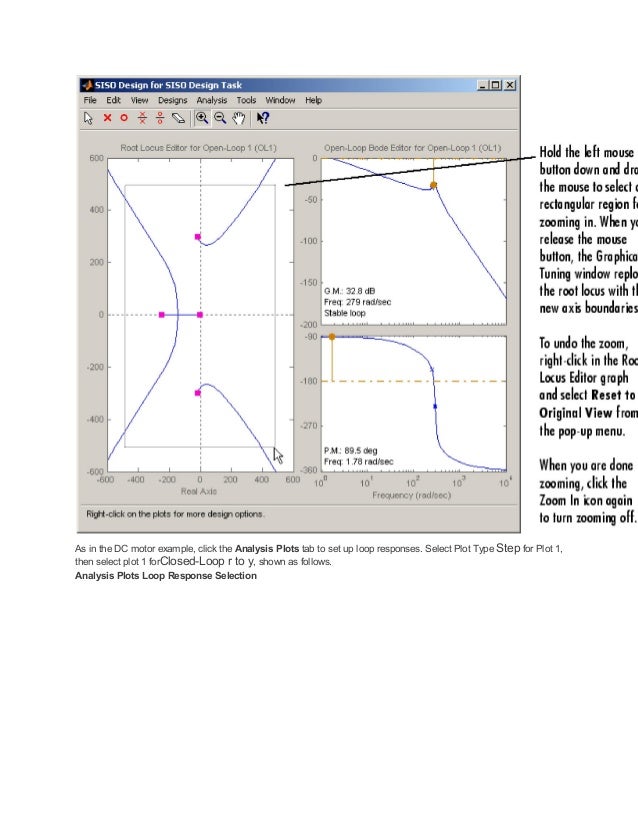

This book is designed and organized around the concepts of controlsystems engineering using MATLAB, as they have been developed in the frequency and timedomain for an introductory undergraduate or graduate course in control systems for engineer-ing students of all disciplines.Ĭhapter 1 presents a brief introduction to control systems. TototototoTTTTTo Lord Sro Lord Sro Lord Sro Lord Sro Lord Sri Vi Vi Vi Vi VenkateswaraenkateswaraenkateswaraenkateswaraenkateswaraĬontrol Systems Engineering is an exciting and challenging field and is amultidisciplinary subject. IIIIIDedicated this bookDedicated this bookDedicated this bookDedicated this bookDedicated this book NEW AGE INTERNATIONAL (P) LIMITED, PUBLISHERS4835/24, Ansari Road, Daryaganj, New Delhi - 110002Visit us at ISBN (13) : 978-8-3

ForĮxample, if you are using PID tuning and you configure your PIDĬontroller block as a PI controller, your tuned compensator must have a zeroĭerivative parameter.Copyright 2006, New Age International (P) Ltd., PublishersPublished by New Age International (P) Ltd., PublishersĪll rights reserved.No part of this ebook may be reproduced in any form, by photostat, microfilm,xerography, or any other means, or incorporated into any information retrievalsystem, electronic or mechanical, without the written permission of the publisher.All inquiries should be emailed to If your application requiresĬontroller constraints, use an alternative automated or graphical tuning method.Īlso, any compensator constraints in your Simulink model limit the structure of your tuned compensator. For example, you cannot tune the parameters of a PIDĬontroller block using these methods. Has constraints on its poles, zeros, or gain, you cannot use LQG synthesis, loop If the compensator in your Simulink model Also, for tuning methods such as IMC and loop shaping, the maximumĬontroller order depends on the dynamics of the effective plant. Methods apply only to compensators whose open loops ( L = C P ∧) have stable effective plants ( P ∧). Understand which tuning methods work for your system. Knowing the properties of the effective plant seen by your compensator can help you The following diagrams show examples of effective plants: Effective Plant for TuningĪn effective plant is the system controlled by a compensator thatĬontains all elements of the open loop in your model other than the compensator you are Using either optimization-based tuning or graphical tuning.įor more information on automated tuning methods, see Design Compensator Using Automated Tuning Methods. You can then improve the compensator performance Obtain a full-order stabilizing feedback controller using the IMCĪssumes that your control system uses an IMC architecture thatĬontains a predictive model of your plant dynamics.Ī common design approach is to generate an initial compensator using PID tuning, LQG Requires Robust Control Toolbox™ software. Maximum controller order depends on the effective plantįind a full-order stabilizing feedback controller with a specified


Tunes the parameters of a previously defined controllerĭesign a full-order stabilizing feedback controller as a Specified in graphical tuning and analysis plots. Optimize compensator parameters using design requirements Or tune controllers using classical PID tuning formulas.Ĭlassical PID tuning formulas require a stable or integrating Option is useful when designing to both time-domain and frequency-domainįor examples of graphical tuning, see the following:Īutomatically tune PID gains to balance performance and robustness Your compensator using both the Bode editor and root locus editor simultaneously. The graphical tuning methods are not mutually exclusive. For more information, see Edit Compensator Dynamics Tune your compensator using the editor plots, and then use the compensator editor toįine-tune the compensator parameters. When using graphical tuning, you can modify the compensator either directly from theĮditor plots or using the compensator editor. Shaping), combining gain and phase information on a Nichols Tune your compensator to achieve a specific open-loop response (loop Tune your compensator to produce closed-loop pole locations thatĭesigning to time-domain design specifications, such as maximum Improving reference tracking, input disturbance rejection, and noise Tune your prefilter to improve closed-loop system response. Tune your compensator to achieve a specific open-loop frequencyĪdjusting open-loop bandwidth and designing to gain and phase margin


 0 kommentar(er)
0 kommentar(er)
